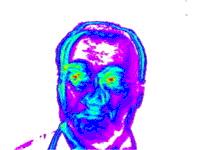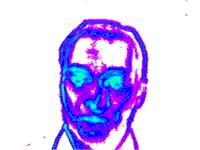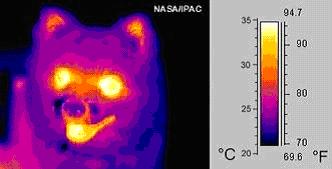
VibraImage
In medical imaging and biometrics, vibraimage is a recent, psycholgically-based, emotional-recognition visual imaging technology that measures microsecond vibrations of video pixels in terms of digital frequency and amplitude parameters. The visualization of a 3-dimensial object, based on vibration parameters, can thus be correlated to various mental states, such as anger, tension, aggression, etc., as well as mood, normal states, and subconscious reflections. Vibraimage can be characterized as one of primary images as visible spectrum, such as infrared, x-ray, MRI or ultrasound imaging. Vibraimage technology is currently being tested in areas such as terrorist recognition, emotional recognition, interpersonal video-dating interactions, as well as for personal use. Visualization of every pixels vibration became possible only in 21st century with the development of digital cameras and high power computers. Long ago, past scientists, such as Aristotle, had realized that biological object movement parameters characterize emotions; thus vibraimage technology is a potential realization of this goal.
History
Etymologically, the word emotion is a composite formed from two Latin words. e(x)/out, outward + motio/movement, action, gesture. Vibraimage is novel technical realization of great past scientist ideas begins from Aristotle, who firstly stand the link between motion and life. The basic technology behind vibra imaging was developed in 1998 by the Russian ELSYS Corporation. The first vibraimage pictures were received in 1996 and the «image processing method» later called vibraimage was patented in 2000 (RU and US).
Vibraimage of biological objects
The greatest scientist and naturalist Charles Darwin stated the link between emotions and movements in the book The Expression of the Emotions in Man and Animals. Later, the famous zoologist and psychologist Konrad Lorenz supposed the functional link between aggression and frequency of movement or vibrations in animals and humans.[2] Vibraimage calculates self-dependent vibration parameters of biological objects by digital camera and computer and transfer movement energy into emotions determination. Human's vibraimage is informative as psychological imaging like x-ray is medical imaging.
Vibraimage and psychodynamics
See also: Entropy and life
The concept of psychodynamics was seeded with the 1874 publication of Lectures on Physiology by German scientist Ernst von Brucke who, in coordination with Hermann von Helmholtz one of the founders of the first law of thermodynamics, supposed that all living organisms are energy-systems governed by the principle of the conservation of energy. In this direction recent scientists, such as Russian physical chemist Georgi Gladyshev, have applied the principles of thermodynamics to living systems. One principle, for example, from chemical thermodynamics, states that dynamic living systems in isothermal, isobaric conditions tend to evolve such that the Gibbs free energy of the system is minimized, during each evolution process.
A way to measure a portion of these energy dynamics, according to Gladyshev, is to gauge values of supramolecular receptors, e.g. sight, sound, touch, etc., of living systems as they interact.[3] Vibraimage, has recently been used in this direction. If two people, for example, are interacting on a video feed, the pair can be considered a closed system; as such, mapping changes in vibration parameters as these correlate to emotional changes, can thus be mathematically correlated to an equation of state for the system in terms free energy changes in relation to each person?s reactions.
The human organism, as per Freud's conception, can be approximated as a thermodynamic system.[4] Accordingly, internal and external stimuli function as energy releasers. As such, the human head, in balance, yields an approximation of the state of the system, whereby head movements, regulated by vestibular system, are coordinated with energy regulation processes as described by hierarchical thermodynamics (1978) and human thermodynamics (2002). In this manner, vibration imaging, as shown below, via frequency and amplitude measurements, theoretically functions as an approximate gauge of this state:

|

|

|
| Color-parameter facial vibraimage showing "amplitude" of pixel vibration. |
Color-parameter facial vibraimage showing "frequency" of pixel vibration. |
Comparision to thermal imaging

|
|
Image of a small dog taken in mid-infrared ("thermal") light (false color) |
Vibraimaging, which can be though of as a type of pixel, micro-movement, vibration recognition image, is similar to thermal imaging, which is a type of infrared imaging. Thermographic cameras detect radiation in the infrared range of the electromagnetic spectrum (roughly 900-14,000 nanometers or 0.9-14 mkm) and produce images of that radiation.
Related
Parts of vibraimaging theory is based on Paul Ekman’s method of analyzing human emotion and microexpressions, for purposes such as lie detection.
Likewise, since 1972, psychologist John Gottman, who also used Ekman’s principles, has used a similar type of video-imaging technology, based on micro-second video recordings of married couples, conjoined with EEG and pulse rate measurements, which he uses to measure the health or pulse of rocky marriages.[5] To date, his famous «love lab» has tracked the marriages of some 700 couples.
See also
- Body language
- Microexpression
- Nonverbal communication
- Facial expression"
- Facial Action Coding System
- Facial feedback hypothesis
- James-Lange theory
- Vestibular system
References
| 1. ^ Pub. No: US 20040131275 Method and device for image transformation, Viktor Minkin, Alexander Shtam, Date Jul. 8, 2004 |
| 2. ^ Lorenz, Konrad (1974, c1966). On aggression. a harvest edt. New York: Harcourt Brace Jovanovich — XIV, 306 pages. ISBN 0-15-668741-0 (A Helen and Kurt Wolff book) |
| 3. ^ Gladyshev, Georgi (1997). Thermodynamic Theory of the Evolution of Living Beings. Nova Science Publishers. ISBN 1-56072-457-9. |
| 4. ^ Hall, Calvin, S. (1954). A Primer in Freudian Psychology. Meridian Book. ISBN 0452011833. |
| 5. ^ Gottman, John; Silver, Nan (1999). The Seven Principles for Making Marriage Work. Three Rivers Press. ISBN 0609805797. |
Further reading
- Viktor Minkin Head movements vibraimage visualization and energetic model of emotions
- Libb Thims, Human Thermodynamics, VI IoHT Publications, Ltd. 2002 (1st Ed.)
- Georgi Gladyshev Hierarchical thermodynamics — General Theory of Existence and Living World Development, Report dedicated to 70th Birthday of Professor Gladyshev, 19 Sept. 2006, Alma-Ata (Kazakhstan, were he was born), National Technical University and National University of Kazakhstan (in Russian, Abstract in English)

© 2001-2008 ELSYS Corp.

